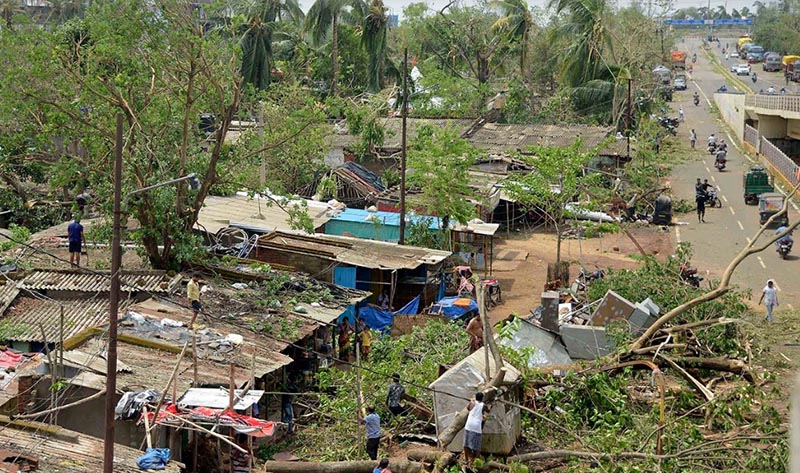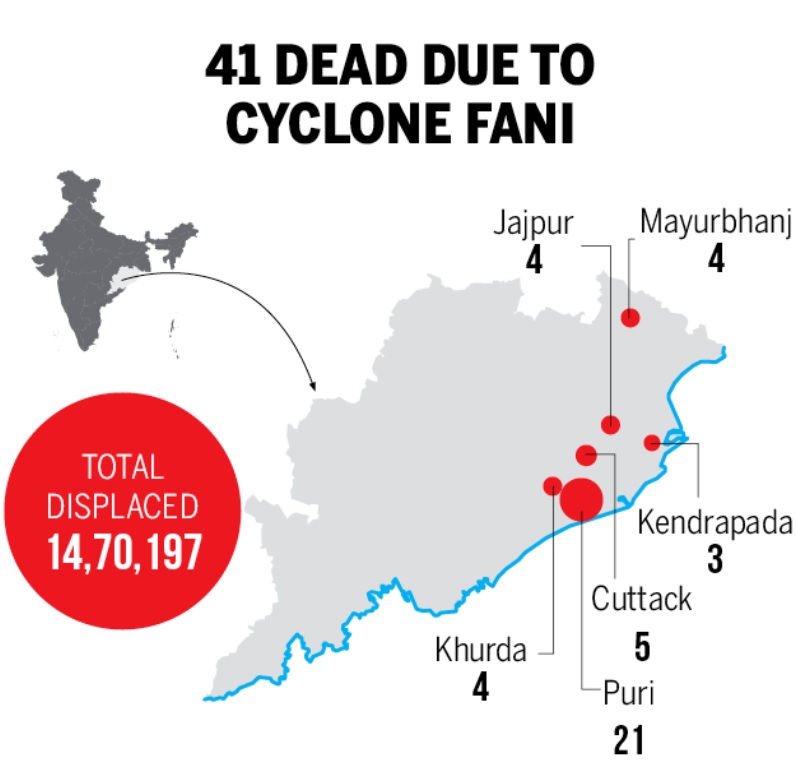[Analytics] Fani’s fury: Far worse than you thought

Thousands of trees have been uprooted across the state due to the devastating cyclone (Pic: Sanjib Das)
No water, no phone, no money in ATMs and no light. As Odisha struggles to come to terms with the damage caused by Cyclone Fani, the grim realities are emerging. Ashok Pradhan specially for the Times of India.
As Cyclone Fani ripped through Puri on May 3, P Chittama found herself locked out of the bathroom that her family was huddled in. The asbestos roof in her house in Penthakata soon gave way to the strong wind and a large piece hit Chittama on the leg. Bloody and barely able to walk, the 40-year-old somehow managed to drag herself to the bathroom which provided safe shelter due to its concrete roof. Hours later, the storm subsided and Chittama was taken to a hospital where doctors told her she was lucky to have escaped with only a fracture. It will, however, take a month for Chittama to be able to walk and much longer than that for her family to rebuild their damaged fishing boat and go back to the sea.
After Fani, Odisha’s story may just be like Chittama’s.
As the accolades the Naveen Patnaik government earned for its timely evacuation of 14 lakh people die down and officials begin taking stock of the devastation, grim realities are emerging.
Forty-one people have died and over 1.50 crore have been affected in 14 districts. Large parts of state capital Bhubaneswar and the entire Puri district remain without electricity and the distribution of drinking water and food supplies is erratic, forcing people to resort to attacking and stealing from relief vans in some cases. Five lakh houses and 6,700 hospital buildings have been damaged while 34 lakh livestock have perished. The total loss in financial terms will run into at least Rs 50,000 crore, government estimates suggest.
Experts said that the ecological, financial and infrastructural damage caused by Fani is much larger than anticipated. Sarat Chandra Sahu, former director of Meteorological Centre, Bhubaneswar, said that the widespread destruction, particularly in Bhubaneswar, which was at least 50 km from Puri where the cyclone made landfall, was unexpected. Sahu said that it was high wind speeds of 200 kmph that allowed the cyclone to wreak havoc at this scale.
Lake Chilka and Balukhand-Konark wildlife sanctuary, two of Odisha’s ecological hotspots, have been hit hard. According to a government report released on Thursday, Chilka, Asia’s biggest brackish water lake, is likely to become more saline due to increased inflow of sea water. The heightened salinity will adversely affect marine life. In Balukhand-Konark wildlife sanctuary on the Puri-Konark marine drive, millions of trees have been uprooted.

Special relief commissioner (SRC), Odisha, Bishnupada Sethi admitted that it might be several years before the state can get back on its feet. “It might take up to a decade,” said Sethi, adding, “The priority is to get people’s lives back on track. The complete damage assessment will take time as communication is yet to be restored in many parts.”
The government is now struggling with the mammoth task of repairing nearly 80,000 km of low tension power lines and 64,000 damaged distribution transformers. Efforts are on to revive the nerve centres of Odisha — Cuttack, Puri and Bhubaneswar. Officials said that electricity will be restored in Cuttack and Bhubaneswar by next week but it would take up to a month to restore power supply to the entire Puri district.
The railway station in Bhubaneswar, one of the few areas in the city with electricity, is witnessing an unusual rush. Desperate to connect with the world and get news of loved ones, people are queuing up at the station to charge their cellphones. And because the charging points are limited, many are now bringing extension cords even as they spend nights on the platform to await their turn. It helps that packaged drinking water is also available at the station.
Information and public relation secretary Sanjay Singh said that water supply in Puri, Cuttack and Bhubaneswar had been restored. Residents, though, maintain that this is pointless as the water being supplied is undrinkable.
In Puri, countless people have been rendered homeless in villages; food is scarce and ATMs are without money. Odisha DGP Rajendra Prasad Sharma said that police are now escorting relief vans after some people tried to snatch material from a truck in Satyabadi in Puri. On Thursday, only 20 out of 273 ATMs and 60 bank branches out of 239 were functioning in Puri. Bang in poll season, the safety of EVMs has posed another challenge. Police are using diesel-run generators to provide power to a strong room in Puri where EVMs have been kept after people cast their votes on April 23.
This came even as Civil Society Responds to Fani (CSRF), a group of organisations and concerned citizens, said that Dalits were being denied access to cyclone shelters and given food only after others had eaten.
For those still coming to terms with the loss of loved ones and their homes, Fani has evoked memories of the super cyclone of 1999.
“Though the deaths were greatly fewer, as far as damage to infrastructure goes, Fani has caused perhaps as much destruction as the super cyclone which had killed over 10,000 people,” said Sanjeeb Guru, an architect.